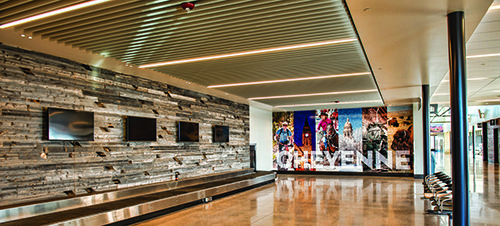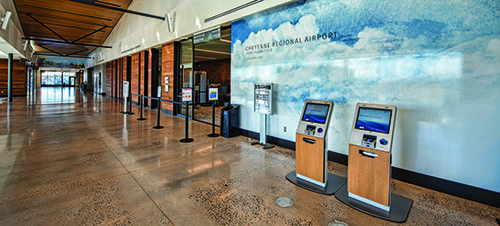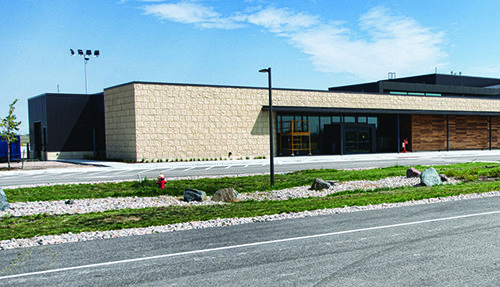After two decades of thinking, planning and finally building, Cheyenne Regional Airport (CYS) recently opened its new $18.5 million terminal. As part of the debut celebration, airport, community and business officials gathered with the public on Nov. 4 to welcome SkyWest’s first flight into CYS from Dallas/Ft. Worth International (DFW), the first of scheduled daily flights between the two locales.
After two decades of thinking, planning and finally building, Cheyenne Regional Airport (CYS) recently opened its new $18.5 million terminal. As part of the debut celebration, airport, community and business officials gathered with the public on Nov. 4 to welcome SkyWest’s first flight into CYS from Dallas/Ft. Worth International (DFW), the first of scheduled daily flights between the two locales.
 “This project was 20 years in the making,” reflects CYS Director of Aviation Tim Barth. “Former Airport Director and AAAE President Jerry Olson envisioned this way back in the ’90s. It was put in master plans and talked about publicly, but even after we engaged Alliiance to design the terminal in 2007, it took another decade to pull the funding together.”
“This project was 20 years in the making,” reflects CYS Director of Aviation Tim Barth. “Former Airport Director and AAAE President Jerry Olson envisioned this way back in the ’90s. It was put in master plans and talked about publicly, but even after we engaged Alliiance to design the terminal in 2007, it took another decade to pull the funding together.”
But all those setbacks are in the rearview mirror. Today the airport’s old terminal, which had a 50-seat capacity doublewide trailer for a holdroom, has been replaced with an open, airy 26,000-square-foot building with a 250-seat holdroom and apron able to accommodate three Boeing 737s.
|
Project: New Terminal Location: Cheyenne (WY) Regional Airport Construction: April 2017-Oct. 2018 Cost: $18.5 million Funding: Airport Improvement Program; WY Dept. of Transportation; airport bonds; “6th penny” sales tax Architecture & Design: Alliiance General Contractor: Q&D Construction Sitework: Aztec Construction Concrete: Reiman Corp. Structural Steel: Puma Services Inc. Heating/Venting/Air Conditioning: Commercial Design Engineering Concrete Polishing: Concrete-Visions Electrical: Simpson Electric Co. Baggage Handling: Automatic Systems Inc. Surveying: Inberg Surveying Co. Inc. Water & Fire Services/Sewer: Mechanical Systems Inc.
Millwork & Siding: Pinnacle Cabinet Thermal Insulation: Moore Foam Systems Roofing & Siding: Big Horn Roofing; Southam & Associates Inc. Overhead Doors: Gold Label Door Co. Glass & Glazing: B&W Glass Inc. Drywall: Western Drywall Inc. Ceilings & Painting: Phase 2 Co. Flooring: Heritage Building Services Signage: Apex Sign Co. Fire Suppression: Rapid Fire Protection Inc. Air & Water Barrier: MTN Inc. Masonry: IMS Masonry Inc. Doors & Frames: Rocha Woodworks Inc. Landscaping: Big Bird Landscaping Office Machines: Capital Business Final Clean: Superior Cleaning Decommissioning Old Terminal & Moving Service: K2 Construction Consultants |
“The old terminal was built back in 1961,” Barth informs. “It was designed to accommodate 19- to 30-seat aircraft. We needed a terminal and facilities capable of supporting regional jet aircraft if we were going to help economic development flourish. The business community’s No. 1 question was: ‘What kind of air service do you have and how will it benefit our business?’ We heard their concerns.”
Airport officials also responded.
Form & Function
General contractor Q&D Construction teamed with architectural firm Alliiance under a construction manager at risk protocol for the terminal project. (A 60-space parking lot and terminal apron was constructed under a separate contract.)
Aesthetics and functionality were key considerations throughout the design and construction process, emphasize Alliiance Principal Eric Peterson and Q&D Aviation Services Vice President Duane Boreham.
 Business travelers typically know their way around an airport, but when leisure passengers arrive, many are thinking about what they forgot at home and whether they have enough time to make their flight. With all of this on their mind, just walking into the airport can be a little intimidating, observes Boreham. “It can be confusing and often they just can’t find their way around. With this airport, wayfinding is simple and flows very naturally. You walk in and there’s the ticket counters; next to that is the security checkpoint. When travelers land and exit, they move smoothly through the holdroom and directly to baggage claim and rental car offices. It’s difficult for a traveler to get turned around.”
Business travelers typically know their way around an airport, but when leisure passengers arrive, many are thinking about what they forgot at home and whether they have enough time to make their flight. With all of this on their mind, just walking into the airport can be a little intimidating, observes Boreham. “It can be confusing and often they just can’t find their way around. With this airport, wayfinding is simple and flows very naturally. You walk in and there’s the ticket counters; next to that is the security checkpoint. When travelers land and exit, they move smoothly through the holdroom and directly to baggage claim and rental car offices. It’s difficult for a traveler to get turned around.”
Even though the old terminal’s halcyon days were far in the past and its functionality severely limited, the community felt a certain nostalgia for the old structure. (Before the airport added the holdroom trailer, travelers waited in the vestibule for their flight). With this in mind, Alliiance designed the new terminal to connect aesthetically with the region and the community.
“Cheyenne may have a rugged edge-of-the-West cowboy town feel, but it also has elegance and beauty,” Peterson explains. “We considered the unique geography of the airport’s location, where the high plains meet the front range. The precast block exterior reflects the rugged terrain and stone buttes. Along the curbside, a long canopy serves as the building’s welcoming ‘front porch.’ Dynamic roof forms wrapped in dark metal project upward, creating strong silhouettes against the sky.
“Inside, the space is uplifting with ceiling heights ranging from 12 to 30 feet. Extensive use of glass helps create volume and brings in light on cold, blustery winter days. The building’s finish palette plays functional, hard-working materials like polished concrete floors and wall treatments made from salvaged snow fencing against refined materials like glazed tiles and rich wood paneling.”
To further reinforce the regional connection, the airport acquired and installed murals and other artwork from throughout the state. “This gives travelers a great sense of what Wyoming is all about,” Barth adds.
Security and baggage handling have been brought into the 21st century. The screening checkpoint in the old terminal could handle about 10 people at a time; the new terminal can simultaneously process 50 travelers. Under the old system, baggage had to be carried through TSA for screening; now bags are placed on a belt for screening.

Amenities include free parking and Wi-Fi, self check-in, rental car kiosks, a gift shop and eventually a restaurant. “We have a request for proposals out on the street and are currently talking to eight potential food and beverage providers,” Barth informs. “In the meantime, we are making arrangements to install a kiosk for snacks.”
Build It & They Will Come
The airport broke ground for the new terminal in April 2017, and soon after its sole air carrier filed for bankruptcy and left. Moreover, American Airlines had bailed in 2012, also as a result of bankruptcy. Not surprisingly, the loss of service left many in the community scratching their heads and wondering why CYS was building a new terminal.
“We took this setback as an opportunity to reeducate the public,” says Barth. “With the diversion traffic from Denver International (DEN) and the various vacation and military charters coming through the airport, the terminal remained in constant use.”
In August, just a few months before the terminal was completed, SkyWest announced it would begin daily flights to and from Dallas/Fort Worth International (DFW) in November. The Cheyenne Regional Air Focus Team helped develop public-private partnerships to secure $2.3 million in revenue guarantees for SkyWest’s first year of operation. After the year is up, the team expects the route to be self-sustaining.

Airport officials project that around 15,000 travelers will fly the SkyWest route in the first year. They also hope the airport can add more flights by next summer—additional DFW flights or new routes to Las Vegas and/or Phoenix.
Barth points out that pricing into and out of CYS is competitive, citing Nov. 7 to 9 roundtrips as an example: $389 for CYS/DFW versus $369 for DEN/DFW. When passengers factor in CYS’ free parking and the cost/hassle of traveling the I-25 corridor to Denver, flying in and out of CYS becomes very attractive, he explains.
From a broader perspective, CYS hopes to fill the air service gap in Northern Colorado and Wyoming that occurred when Allegiant Air pulled out of Fort Collins and Casper. “When we looked at the numbers Allegiant had in Fort Collins, half the people were from Wyoming to begin with,” Barth notes.

The Right Process
Peterson and Boreham both agree that following a construction manager at risk approach was a key factor in completing the terminal on time and within budget.
 “We all came to the project with a collaborative and common vision,” Peterson remarks. “Communication played a big role—the willingness to listen to one another and realize that we were all on the same team working toward a common goal,” adds Boreham.
“We all came to the project with a collaborative and common vision,” Peterson remarks. “Communication played a big role—the willingness to listen to one another and realize that we were all on the same team working toward a common goal,” adds Boreham.
TSA was a concern at the front end of the project because of personnel changes and communication issues, recalls Barth. During a trip to Washington, D.C., however, the project team made a special effort to bring TSA into the project. “That really opened the door for us,” he recalls. “They had never really been invited to the table before. It ended up making the state and FAA believers that the construction manager at risk delivery method is a viable approach that airports should consider when going vertical with construction.”
Peterson reports that local interest in the project dramatically increased over the course of construction. While the business community understood the need for a new terminal from the beginning, enthusiasm from the broader community wasn’t evident until the terminal was built. “Air service is back and the terminal feels like it belongs,” he observes.
With the new terminal complete, Barth now wonders whether the loss of air service early in construction was ultimately a blessing. “We had more flexibility, less pressure and less of a sense of urgency throughout construction,” he relates. “We were able to take our time and do it right, construct a building that was going to be in the community for the next 50 years.”


 facts&figures
facts&figures

